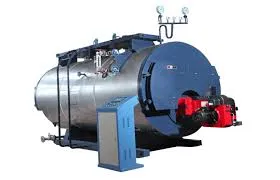
नोभ . 12, 2024 15:18 Back to list
thermal oil furnace
Understanding Thermal Oil Furnaces A Comprehensive Overview
Thermal oil furnaces are crucial components in various industries, providing efficient heat transfer for a wide range of applications. Unlike traditional steam boilers, thermal oil systems use thermal oil as the heat transfer medium, allowing for precise temperature control and high thermal efficiency. In this article, we will explore the operation, advantages, applications, and maintenance of thermal oil furnaces.
How Thermal Oil Furnaces Work
A thermal oil furnace consists of a burner that heats thermal oil within a closed-loop system. This oil circulates through the furnace, absorbing heat generated by the burner. The heated oil then flows through a series of heat exchangers where its thermal energy is transferred to the processes or equipment requiring heat. The oil returns to the furnace to be reheated, completing the cycle.
The operating temperatures of thermal oil systems can reach up to 400°C (752°F), which is significantly higher than water-based systems. The ability to maintain these high temperatures without creating excessive pressure makes thermal oil furnaces particularly valuable for applications requiring consistent, high-quality heat.
Advantages of Thermal Oil Furnaces
1. High Efficiency Thermal oil furnaces have an exceptional heat transfer capability, which allows for quick heating and efficient energy usage. This can lead to lower fuel consumption and reduced operational costs.
2. Temperature Control The use of thermal oil enables precise temperature regulation. Operators can easily adjust the temperature to suit specific operational requirements, leading to improved process control.
3. Safety With a closed-loop system and lower operating pressures compared to steam systems, there is a reduced risk of catastrophic failure. Additionally, thermal oil is less prone to explosive vaporization, enhancing overall safety.
4. Versatility Thermal oil furnaces can be used across various industries, including oil and gas, food processing, chemical manufacturing, and more. Their ability to operate at high temperatures without the need for high pressure makes them adaptable to different applications.
5. Reduced Maintenance Costs Compared to traditional boilers, thermal oil systems typically require less maintenance. The thermal oil does not need to be replaced frequently, leading to lower operational downtime.
thermal oil furnace

Applications of Thermal Oil Furnaces
Thermal oil furnaces find applications across multiple sectors
- Chemical Industry Used for heating reactors, distillation columns, and other equipment that requires uniform and stable heat supply. - Food Processing Ideal for food drying, frying, and cooking processes where precise temperature control is essential. - Textile Industry Used for drying, curing, and finishing processes that require reliable heat management. - Plastic Manufacturing Employed in processes like extrusion and molding, where maintaining consistent temperatures is critical for product quality.
Maintenance of Thermal Oil Furnaces
Proper maintenance is vital to ensuring the longevity and efficiency of thermal oil furnaces. Here are some key maintenance practices
1. Regular Inspections Scheduled inspections can help identify potential issues before they escalate into significant problems. This includes checking for leaks, inspecting insulation, and examining the burner and heat exchanger components.
2. Thermal Oil Quality Monitoring The quality of thermal oil degrades over time due to oxidation and thermal breakdown. Regular testing and monitoring of oil properties, such as viscosity and acidity, are essential to ensure optimal performance.
3. Cleaning The heat exchanger surfaces should be kept clean to maintain efficient heat transfer. Scale and soot buildup can impair performance and increase energy costs.
4. System Calibration Regular calibration of temperature controls and safety systems guarantees that the furnace operates effectively and safely.
In conclusion, thermal oil furnaces offer a reliable, efficient, and versatile solution for high-temperature heating applications across various industries. With proper operation and maintenance, they provide an excellent return on investment and contribute to enhanced productivity and safety in industrial processes. Understanding their functionalities and benefits is crucial for any operation looking to optimize its thermal management systems.
-
Efficient Biomass Fired Hot Water Boiler | AI Heating Solution
NewsAug.01,2025
-
High-Efficiency Gas Thermal Oil Boilers | HPT Models
NewsJul.31,2025
-
Oil Fired Hot Water Boilers Sale - High Efficiency & Affordable
NewsJul.31,2025
-
High-Efficiency Commercial Oil Fired Steam Boiler for Industry
NewsJul.30,2025
-
High-Efficiency Biomass Fired Thermal Oil Boiler Solutions
NewsJul.30,2025
-
High Efficiency Gas Fired Thermal Oil Boiler for Industrial Heating
NewsJul.29,2025
Related PRODUCTS






















